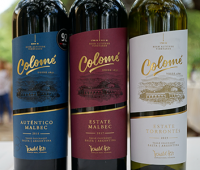THE MAGIC OF FOUR ALTITUDES
Founded in 1831, Bodega Colomé is the oldest continuously working winery in Argentina. Likely established by the Spanish Governor of Salta, it received the first pre-phylloxera French Malbec and Cabernet Sauvignon vines brought by the governor’s daughter in 1854, some of which still contribute their fruit to Colomé wines. For Donald and Ursula Hess, who acquired the property in 2001, the winery became the fulfillment of a dream and a great adventure.
In a magical corner of the Calchaquí Valleys in Salta, they found a place where the extreme climate and many years of experience made it possible for Bodega Colomé to create the world’s most recognized high-altitude wines, a mission that the next generation now continues. Grapes for the Colomé wines are grown in four vineyards at four different altitudes ranging from 1,750 to 3,111 meters (5,740 to 10,200 feet) above sea level - incredible heights within one of the world’s very highest wine growing regions.
At these altitudes, dramatic daily temperature swings cause grapes to develop a concentrated, natural acidity, and the fierce sun exposure encourages thicker, darker grape skins. These factors produce aromatic wines of intense color and flavors that also exhibit a natural freshness.
The extreme microclimate here requires expertise and patience. Along with altitude, time is the other critical ingredient in the making of Colomé wines. The team takes its time caring for the four vineyards with organic and biodynamic practices, giving the fruit time to ripen and mature in its natural environment, and supporting the mystic energy that combines in the wines to reflect Salta’s splendor.
 Back To Menu
Back To Menu

